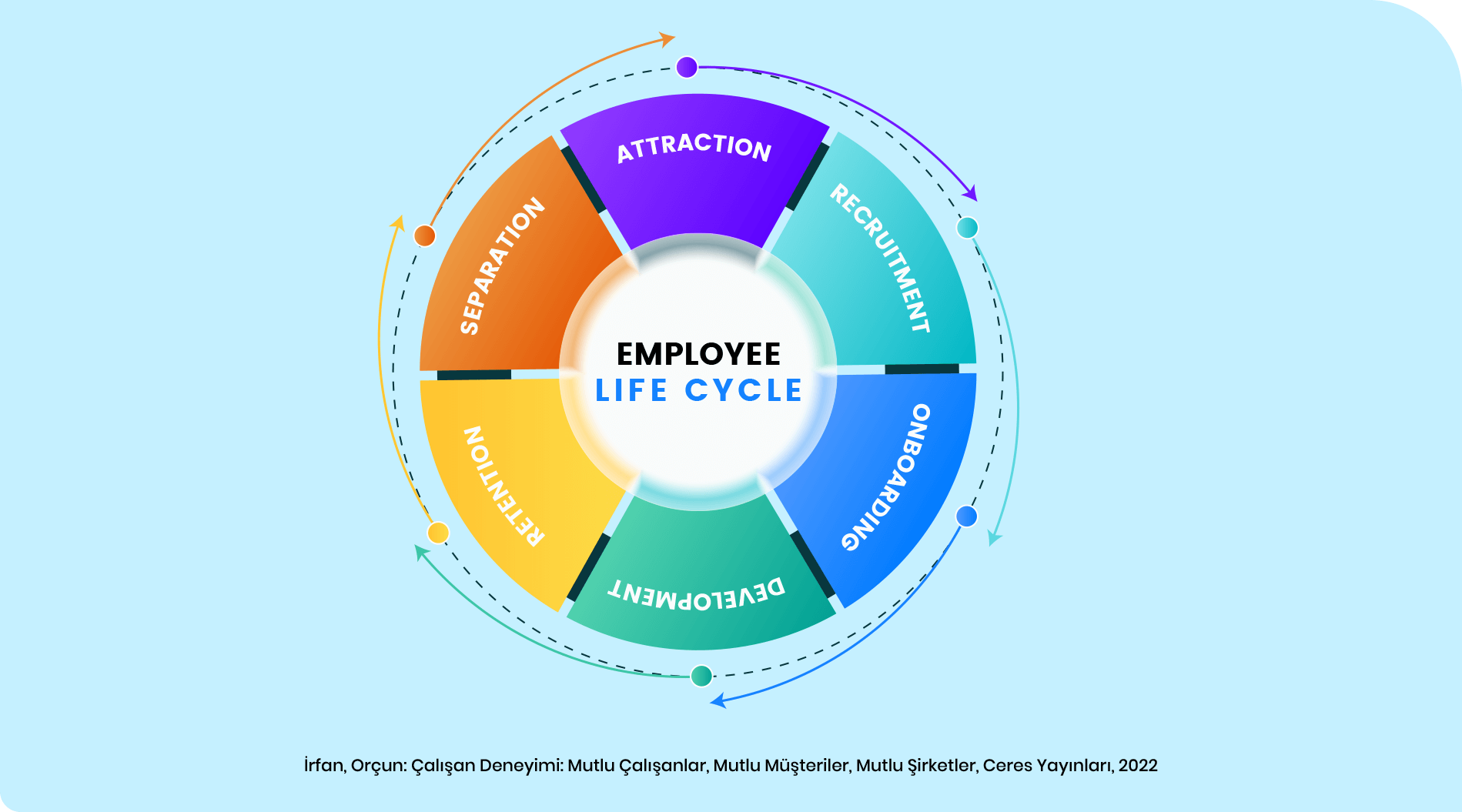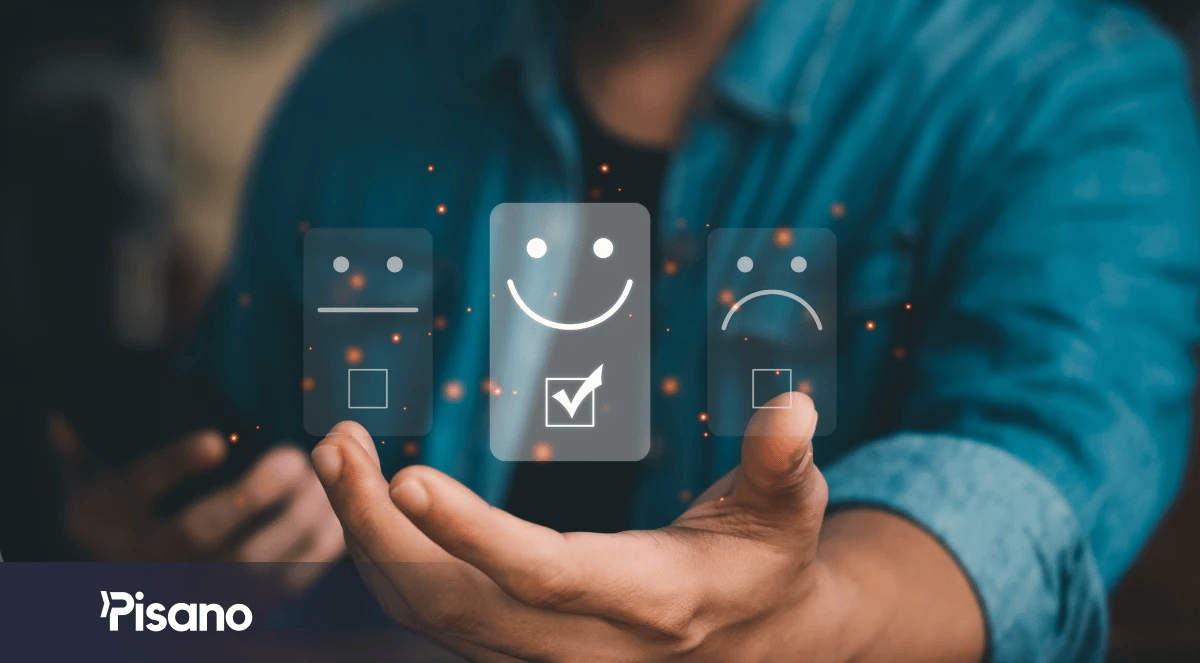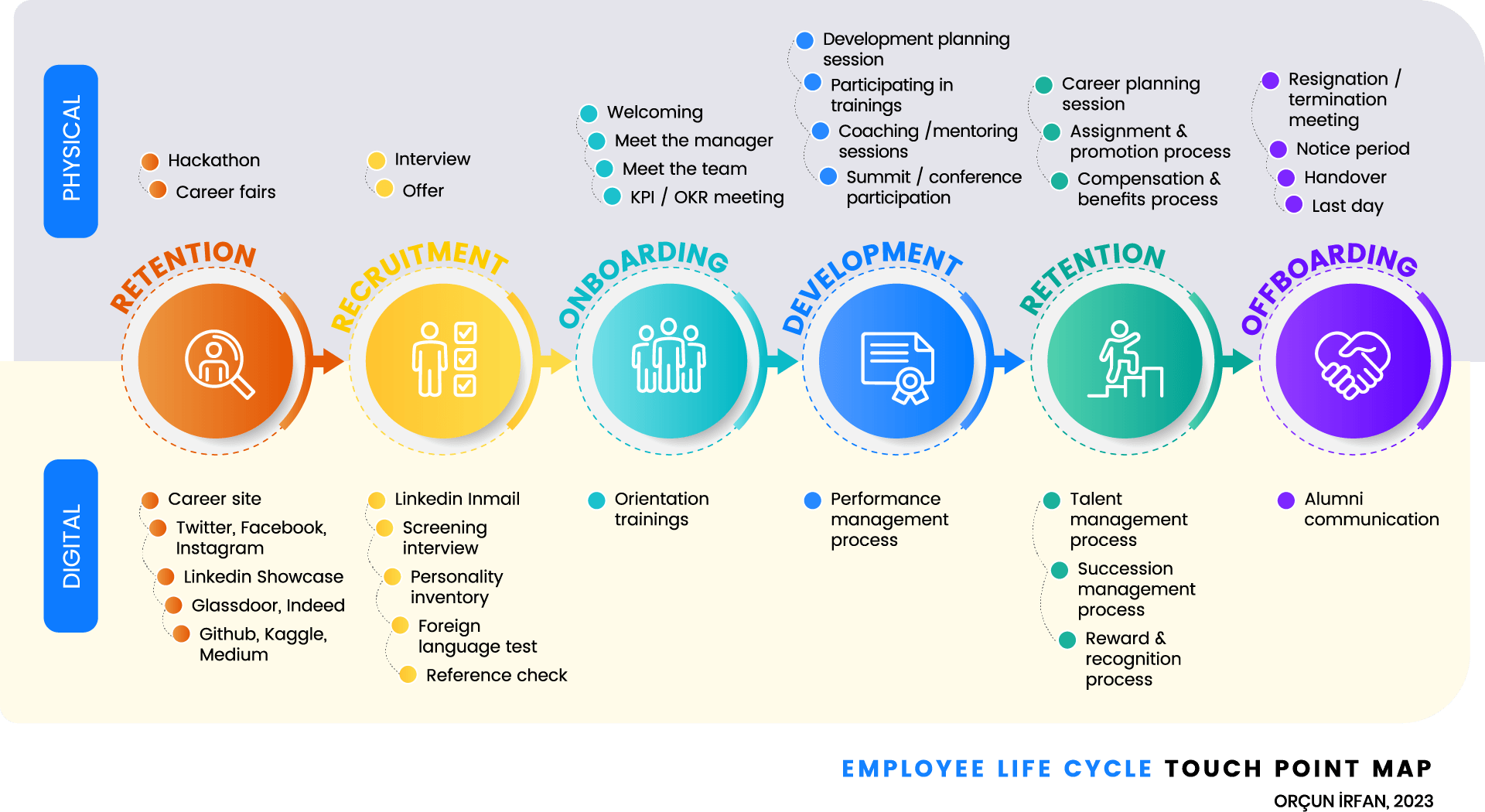We start an employee experience training naturally by defining what employee experience is.
Let's start this article with a brief definition in the same way.
Employee experience is the holistic perception that employees acquire as a result of their interactions with their organization.
As you may remember, we have discussed and interpreted this definition in detail in our previous articles.
Two expressions that I emphasized in this short, but almost every word important, definition are among the very important components of the employee experience.
Interaction and holistic perception.
Now let's ask a few important questions.
- How does the employee interact with the employer?
- What is the holistic perception formed as a result of these interactions that the employee has with the employer?
- Can the experience at the interaction points and therefore the holistic perception that will occur at the endpoint be designed in advance and consciously?
The two statements we have emphasized in the summary definition open the door to an enormous playing field thanks to these important questions.

In order to give a comprehensive answer to the first question, we first need to talk about the employee life cycle, a model that has been used for a long time in the field of human resources and which we have included in our previous articles.
The Employee Life Cycle that Works as a Rooftop Journey Map
Employee Life Cycle (ELC) is an umbrella journey map that allows the employer to track and manage the total career process of a particular employee by dividing it into phases.

Although the model has 5, 6, and sometimes even 7 pieces representations, I will base this article on its 6-part version, which I included in my book on employee experience that was published by Ceres Publications in 2022.
First of all, let's have a look at each phase of the model one by one to have a good grip on it.
Employee Lifecycle: Attraction Phase
Attraction phase in the employee life cycle is the main playground where organizations carry out their employer branding activities. Organizations basically appeal to the talents they want to work with at this stage, make their brand visible and try to position themselves as an attractive employer to work with.
In summary, employers at this stage ask the talent groups in their target audience, "Why should you work with me and not elsewhere?" They answer the question and support their answers with six-packed arguments.
University career festivals, internship programs, hackathons or ideathon activities, career tabs on the corporate website, corporate social media accounts, and platforms that focus on the business world such as Linkedin, Glassdoor, and Indeed are the most frequently used channels in this phase.
Although the people reached during the attraction phase are not employees of the organization yet, they are included in the employee life cycle as they are potential employee candidates.
But, how do candidates interact with organizations during the attraction phase, and what is the impact of these interactions on holistic perception?
Let's start with an example of a physical channel first. For example, your booth at the career festival is an interaction point. How your stand looks, is decorated, and how your stand attendant greets students, answers their questions and gives promotional materials determines the quality of the experience between the student and your organizational representative.
Thus, students leave your booth with a positive or negative perception of you as a result of their interaction.

Let's take a digital channel example this time. The same is true for the career tab on your corporate website. When your candidates visit your career tab (assuming you have a career tab) they interact with your organization and have a (digital) experience during their time on your site based on many factors such as design, ease of use, richness of content and the way the corporate culture is expressed. As a result of this experience, they leave your site with a positive or negative perception about you.
Employee Lifecycle: Recruitment Phase
In recruitment phase, we evaluate the candidates whom we succeeded in influencing and convincing to submit an application during the attraction phase through various tools such as interviews, personality inventories, foreign language tests, and assessment centers while increasing the depth and duration of interaction with the candidate.
Moreover, this phase also hosts some moments that raise emotions such as taking an offer or a negative return. These moments have a high potential to turn into a memory. Although we have touched on this subject from a broad perspective before, I think it is important to briefly touch upon the moments that matter at this point.
Moments that Matter in Employee Experience
In our previous articles, we mentioned, a professor at Cornell University Psychology Department. And based on Dr. Gilovich's work, we explained the formation process of experience with the flow of Event → Emotion → Experience → Memory.
In other words, before we can talk about experience, we need a triggering event first. Employee lives some emotions at the time of this event. These emotions turn into experiences which in turn become memories by shaping the thoughts of the employee after the event.
These moments, which appear in the ordinary course of life, can sometimes be extremely intense and have the potential to turn into a direct memory with a high emotional load. We call such moments the Moment of Truth (MoT).
Moment of Truth in Employee Experience
We can define a moment of truth as the moments when the brand does or does not fulfil its promise, especially in difficult times.
Let's make it concrete by giving an example from the customer experience side.
You will get insurance for your car. The company representative you interviewed sells you a policy by promising towing service, a replacement vehicle and if necessary accommodation in case of an accident.

Late one night, your tire is flat on a deserted road while your kids are sleeping in the backseat. You pull over and call your insurance company while the wolves howl outside. The voice on the phone tells you that there are no available tow trucks at the moment and they can reach your location in at least 1 hour.
The moment of truth.
Would you buy insurance from the same company again? I don't think so.
In this sense, moments of truth have the potential to break the ongoing relationship between the customer and the brand or to strengthen a relationship that is about to break with a very positive experience.
Let's also give an example of employee experience. For example, consider an organization that makes many promises about diversity, inclusion and positive discrimination but closes a position where a female employee at her maternity leave can easily be a strong candidate for, with a male internal candidate before the female employee returns from maternity leave.
The moment of truth.
Moments To Memories In Employee Experience
Although the intensity of a moment of truth is great, the frequency of encountering situations that have such a high impact is relatively low.
On the other hand, there are many moments in life that have a high potential to turn into memories in the daily flow. Especially today, when business and private life are intertwined, how organizations want to take place in the memories of employees in such moments makes experience management even more important.
These special moments, which are called moments that matter (MtM) refer to the moments that the employee experiences a specific event either for the first time in life or something that occurs very rarely, such as a job offer, first day at work, first promotion, birth of a child, passing of a loved one...
Now, if you wish, let's close this parenthesis and go back to the employee life cycle without getting further from the subject.
At what interaction points do the candidate and employer interact during the recruitment phase, the second phase of the employee life cycle, and how do these interactions contribute to the holistic perception that will occur?
For example, the channel your recruiters use to reach the candidate is an interaction point. The spoken/written language and attitude used in these channels directly affect the experience at this point of interaction.
Interviews are another important interaction point. The approach shown to the candidates in the interviews, the interview setups, and the corporate culture observed by the candidate in the interviews are all factors that affect the experience.
Each of the tools used in the recruitment process, such as personality inventory and foreign language test, is an interaction point. The modernity, up-to-dateness or user-friendliness of these tools will affect the experience.
Many factors, such as how quickly you return to the candidate at the end of the process, are important in shaping the experience you create in this phase and therefore the holistic perception created for the candidate.

So, can the experience in these moments of interaction and the holistic perception that will occur as a result of the process be consciously designed?
For example, let me share that a Telecom company receives location data from the base stations when the candidate approaches the HQ and informs the responsible recruiter that the candidate is nearby and thus the recruiter greets the candidate in front of the door.
The same company welcomes a younger generation candidate in a more energetic interview room where paperwork is managed digitally and a senior candidate in a more traditionally decorated interview room where paperwork is carried out with physical paper and pen.
At the end of the process candidates who are evaluated negatively are sent a code via SMS and they are given the opportunity to donate to a non-profit organization of their choice in order to thank them for their time during the process.
Needless to say, the employer brand of this company benefits greatly from the positive posts made by even the candidates who were eliminated from the process.
When you think about it, good things are possible, right?
Employee Lifecycle: Onboarding Phase
Onboarding stage, the third stage in the employee life cycle, consists of all the necessary activities for the employees whose recruitment has been completed and who need to adapt quickly to their teams, managers and corporate culture to carry out their work efficiently as soon as possible.
As the phase that recruited candidates will be a part of at least during their probationary period the onboarding phase is very much synergistic with the recruitment phase.
On the first day all activities such as meeting the manager, meeting the team, setting up the company computer, receiving the company vehicle, orientation training, getting annual targets are all points of interaction and each of them gives an experience to the employee.
If you do not greet the employee on the first day, leave the employee on his own without saying a welcome, do not take the time to show the employee around... Well, naturally you will not leave a very positive experience.
Drowning the employees in orientation trainings that are boring, old-fashioned, useless and disconnected from each other is another example that does not provide an exciting and inspiring experience.
And the holistic perception that you leave on the employee who returns home after such a day will not be very bright.
Employee Life Cycle: Development Phase
The development phase is the stage in which all structured training & development activities that will contribute to the personal and professional development of employees whose adaptation is ongoing, are carried out. It is the fourth step of the employee life cycle.
In this sense, there is an extremely synergetic relationship between onboarding and development, just as there is a link between recruitment and onboarding.
At this stage, the training that the employee receives, the coaching, mentoring sessions, one-to-one feedback meetings with the manager, the performance management process the employee is involved in (assuming that it is made for development purposes) are all moments of interaction and each of these moments naturally gives the employee an experience.

Of course, the fact that the employee cannot find any of these practices mentioned above in the organization will of course create a different experience. In other words, you give a message to the employee about the culture not only with the malpractice of the activities mentioned above but also with the nonexistence of these applications.
At the end of the development phase activities, which generally span almost a full calendar year, the employee says, “I'm glad I work here! Here, my progress is valued and they invest in me. How lucky I am!” or “Nobody cares for me here. I'm not supported. I'm not even asked what I need in order to do what is expected of me.”
The experience desired to be given to the employee and the perception that is expected to take place in the employee at the end of the process can be easily worked in advance and in a highly structured way.
Employee Life Cycle: Retention Phase
Retention phase is the pinnacle objective that all phases of the employee life cycle want to achieve. To keep the efficient, productive, happy and engaged employee within the organization.
In this sense, it works very synergistically with the development phase of the employee life cycle.
Talent management meetings, career management plans, promotion & assignment processes, succession maps, salary and benefit increase communications are all important interaction moments during the retention phase.
The design quality and execution effectiveness of these moments directly affects how the experience of the employee will be shaped.
While well-thought-out layouts that are designed according to the user's needs create the following feeling in the employee:
“There is a good future for me here! I can develop my career here and I can easily see my future. I am improving and getting the reward of my hard work!”
Poorly designed processes or having not designed in put into practice anything at all can easily create the following perception in the employee:
“What am I doing here? I don't get paid for my work. And no matter how hard I try I can't get anywhere. Best to start looking for a job.”
Due to the nature of the activities it contains, the effect of this phase spreads over a period of time that goes beyond a calendar year and the experience and holistic perception created in this phase may cause the employee to either become an engaged one or a quite quitter who wants to leave the organization as soon as possible.
Employee Life Cycle: Offboarding Phase:
Offboarding phase is the last stage of the employee life cycle and constitutes all of the activities necessary for the employees who have parted ways with the organization to leave the company in a smooth and healthy process with positive impressions about the organization.
Resignation/termination of employment interview, notice period, handover, last working day, exit interview and even communication with alumni communities are all important moments of interaction in this phase.
Employees who leave the organizations will naturally tell their spouses, friends and acquaintances about their experiences and memories of their former employers and will give positive or negative opinions to those they know who will go to job interviews with their former companies. Therefore, depending on the holistic perception they have about their former companies, they will either turn into cultural ambassadors who will make a positive impact on the employer brand of the organization or become culture activists and will work against the employer brand.
In this sense, thanks to the synergy it creates with the attraction phase, offboarding phase combines the employee life cycle literally as a cycle.
Touch Points in Employee Experience
We talked about the interaction points throughout the article. Before concluding our article let’s name them properly as touch points in employee experience.
If we are able to provide the user with an experience in line with the designed plan, the touch point in question turns into a gain point for us.
If the experience at the mentioned touch point is flowing against the designed plan, this time it turns into a pain point for the user.
As experience designers, our job is to follow the flowing experience, if possible in real-time, at all these touch points and turn possible pain points to gain points with timely interventions when necessary.

Perhaps it may be possible to follow these touch points in small companies with low employee numbers and where everyone works in the same physical environment with the naked eye or with simple applications such as Excel and Google Sheets.
However, it is not possible to measure and follow the instantaneous experience with the naked eye and with individual effort in companies with a high number of employees especially where working environments are spread over different geographies and even time zone and on top of that, operating in the hybrid model.
Usage of Touch Point Maps in Employee Experience
A touch point map is a tool used frequently in the customer experience. It is very useful in terms of drawing the big picture by revealing in which channels and in what ways the customer interacts with the brand.
The touch point map, like the journey map, is a tool that can be made in different ways and can be interpreted according to needs. If you so desire you can set up the entire map in a way to define only the touch points related to the users in a certain service design or to show all the touch points you provide during an entire journey with the physical and digital channel separation.
You can find a sample touch point map of the employee life cycle that we discussed in this article as follows.
This map depicts the touch points where employees interact with their employer throughout their careers divided into segments in physical and digital channels.

But how do we measure, track and manage the experience flowing through all these touchpoints?
Touch Point Management and HR Analytics
At this point, HR Analytics, another important companion of employee experience, comes into play. In our next article, we will take a closer look at the discipline of analytics, where employee experience collaborates to generate value from data and the amazing synergy between employee experience and HR Analytics.
How Pisano EX Can Help You
As I always say, employee experience is a data-driven discipline. The way to unlock the full potential of the employee experience is to first get the voice of the employee (VoE) through as many channels as possible and in a way that makes things easier for the employee then to refine this voice and make it understandable and actionable for all relevant stakeholders.
Thanks to its design developed together with HR professionals, Pisano EX enables 20 critical touch points and 3 moments that matter over 5 phases of the employee life cycle from recruitment to separation with pre-prepared questionnaires specific to the target audience. Moreover, it reports these metrics on real-time streaming data and with an industry-first employee lifecycle score (ELC Score).
For more information about Pisano EX, you can contact Pisano right now.
If you are interested in the employee experience, a young data-based discipline with a huge potential still waiting to be discovered see you in our next article!
-1.png?width=290&name=MicrosoftTeams-image%20(9)-1.png)



